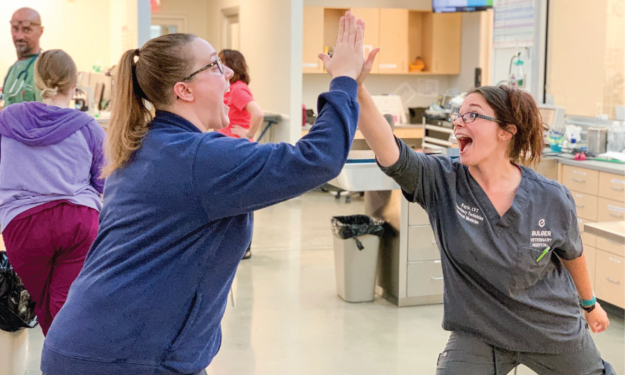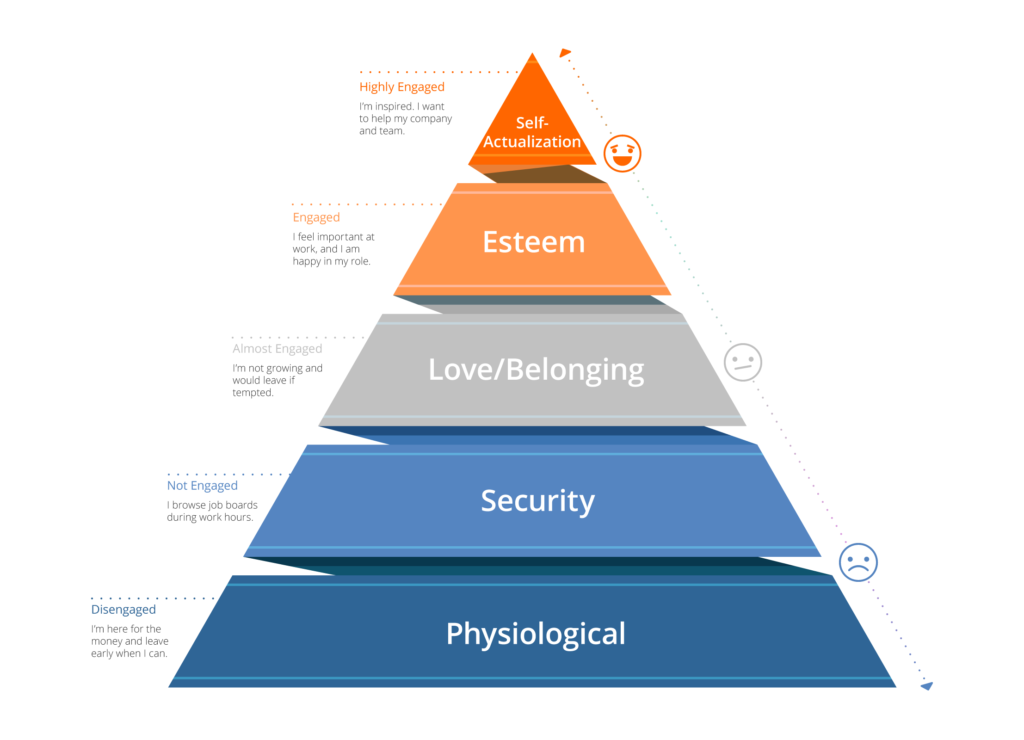Hospital Hierarchy of Needs: Veterinary Medicine Edition
January 20, 2020
Welcome to our new blog series: Ethos Exchange! Every quarter, Ethos Veterinary Health leaders (both hospital and executive) from across the country meet and utilize online articles to discuss management topics in relation to our work in veterinary hospitals. By compiling the ideas, questions, and insights that are generated in these meetings, we hope to help other veterinary practices learn new tools and better ways to manage their hospitals and teams.
In December, we discussed Maslow’s Hierarchy of Work, derived from Maslow’s Hierarchy of Needs. This tool can be useful in onboarding, company culture, professional development, and recruiting efforts in the workplace.
How the pyramid model fits into veterinary hospitals (does it?)
Question posed: This article from ClearCompany’s Meredith Wholley describes the five needs to be met as: physiological, safety, belonging, esteem, and self-actualization. Do you agree or disagree with these stages?

Veterinary hospitals are slightly different than your average business or office setting. At Ethos, and in most veterinary hospital settings, many employees are already at the self-actualization level at the top of the pyramid to begin with. The veterinary profession inherently calls for the pursuit of meaningfulness in work, which contradicts the idea that the first four needs must be met before achieving self-actualization. In other words, veterinary professionals don’t necessarily need to meet their physiological, safety, belonging, and esteem needs in order to feel self-actualized, because they already do in working with their patients and clients.
Perhaps this model should not be a pyramid, but rather a wheel.
“Different needs come in and out of focus depending on the task and the status of your team.” – Danielle T., Associate Medical Director at Massachusetts Veterinary Referral Hospital
Helping employees reach self-actualization
Question posed: This article from ClearCompany’s Sara Pollock addresses self-actualization for functional group positions, but how do we weave this concept into our clinical work? Can this improve burnout and stress on the floor?
A self-actualized employee “continually and willingly aims for improvement, seeks challenges, and pursues meaningfulness in their work.” (Wholley). According to Maslow’s Hierarchy, this need can only be fulfilled after fulfilling the first four needs.
Creating understanding
Self-actualization may be achieved by creating understanding. This can apply to employee-to-client interaction, such as when a technician communicates medical information to a client.
It can also apply to employee-to-employee interaction. When creating understanding among employees, it’s important to maintain a level of professionalism so that the team may function collaboratively and empathetically but without dysfunction caused by complicated dynamics. Instead of referring to a team as a family (which can be very dysfunctional), perhaps a veterinary team should function more like a choir.
“I always think about it in terms of a choir. Not everyone takes a breath at the same time, we’re all taking breaths at different points in time so that you can’t see the breath happening, but the note is still seemingly carried.” – Rachel R., Hospital Service Manager at Port City Veterinary Referral Hospital
Working harmoniously and “taking breaks” in turns allows the team to understand and support each other at a human-level, while also working functionally at a hospital-level.
A constant reminder of the big picture
Perhaps it’s helping our employees put themselves in the context of the bigger scheme. It’s easy to get caught up in day-to-day tasks, but there is a bigger picture in the broad number of patients we care for and the innovation in veterinary medicine we help drive. Reminding our employees of this bigger picture and collective goal is a much more sustainable value model for each individual. It’s not just about getting that one patient home, it’s about getting hundreds of patients home every year.
Establishing trust from the start
It could also be ensuring that the building blocks (the four other needs) are in place. An important piece of this is nurturing trust among employees, especially when onboarding and training a newcomer. Lack of trust between an already-established team and a new employee “outsider” can prevent that person from fulfilling their needs.
Taking care of ourselves
Furthermore, how do we as managers then ensure that we fulfill our own needs? It could be maintaining a good work-life balance, being a little selfish sometimes, reenergizing, and nurturing your life outside of work is important to prevent burnout and to serve as a role model for your employees. It could also be simply being a real, approachable, relatable human being. It’s okay to not be the perfect role model every day, and it can even be helpful in building connections and trust.
The importance of onboarding
Question posed: Wholley’s article shared that 69% of new hires are more likely to stay with a company longer than three years if they go through exceptional onboarding. In what ways do we need to onboard employees to Ethos, the hospital, department, and role?
Ask questions
During the onboarding process, asking the right questions right from the beginning is key. What is that employee’s growth plan? What do they expect as basic needs? Getting the answers to these can provide insight on how we can help that employee fulfill their needs.
Teaching culture separately from training
At Ethos, we provide an orientation day that is separate to on-the-floor training. Our orientation trains new employees on the culture and lifestyle of Ethos, not the job they’re going to have. This may be an important part of onboarding that is often overlooked. How to perform their specific job comes secondary (meaning after) to teaching the company culture. The culture should be taught early in order to help new employees feel familiar and comfortable with working in the organization long-term.
Build a sense of belonging
Building a sense of belonging from the start is important as well.
“Back in middle school when you would walk into the cafeteria on the first day of school and think ‘where am I supposed to sit?’ That happens every time you start a new job.” – Jared K., Talent Acquisition Manager for Ethos Veterinary Health
A simple icebreaker, such as sending out an introductory email to your team with some fun facts about a new employee, can help spark conversations and foster strong connections as a foundation. This helps break the feeling of “just another job” to a long-term career.
Allow for professional growth
We can’t forget about professional growth! Allowing our employees mobility in their careers as well as continuing education opportunities creates an environment of excitement in the possibility of growing with the organization.
This can also take the form of celebrating individual employee successes and work anniversaries (when recognition is wanted.) A sense of belonging is built on small, simple things and more importantly, remembering those small, simple things.
Generational differences
We also must realize that there are generational differences in fulfilling these needs. What one employee may need to fulfill their physiological needs may be completely different from another’s.
Stay tuned in January for more on this topic!
Takeaways
- Help your employees who are struggling: be there for them, listen, and give them the tools to do better.
- Keep track of your “coasters”: don’t forget about your employees who are just coasting along on their day-to-day tasks. Just because they’re getting the job done doesn’t mean they’re satisfied for the long-term! Talk to them and see how they want to improve and fulfill more of their needs.
- Evaluate your onboarding process: especially if you don’t have one. Establish a process and then throw your hospital’s flavor into it so it feels like your culture.
- Listen: people will tell you what they want and what they need. Employees aren’t always straightforward with telling you what they want, so you must listen for keywords that will help you help them get to where they want to be.
Next topic: Generational Similarities in the Workplace
Works Cited
Pollock, Sara. “Maslow’s Hierarchy of (Work): Discover Professional Development.” ClearCompany.com, blog.clearcompany.com/maslows-hierarchy-of-work-needs.
Wholley, Meredith. “How Does Maslow’s Hierarchy of Needs Apply to Your HR Department?” ClearCompany.com, blog.clearcompany.com/how-does-maslows-hierarchy-of-needs-apply-to-your-hr-department.
Written by RACHAEL GILLIS